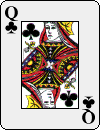
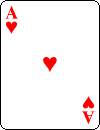
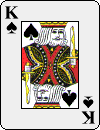



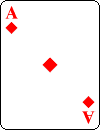
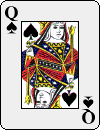



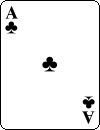
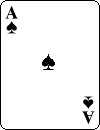
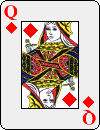
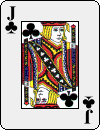
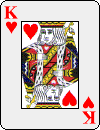
Such "orthogonal Latin squares" have a long history, going back at least as far as Jacques Ozanam in 1725, and were again considered by magician Jean Hugard fifty years ago.
The above array can be dealt from a suitable packet of sixteen cards in four rows from left to right, where we suggest that the cards in each column overlap a little to facilitate subsequent gathering by columns.
Actually this array was derived from the solution which Jim Wilder gave (linked from his blog) by repeated application of these steps: gather up each column of that array, from top to bottom, and re-assemble the packet by collecting the columns in any order, and deal again from left to right, then once more collect the columns in any order, and so on.
Further applications of this type of mixing yields the array below:
















This shares two crucial properties with the first array above and the one at Wilder's link: Each row (and each column) contains each suit once, and each row (and each column) contains each of the four values J, Q, K, A once.
Natural questions arise, which we leave interested readers to ponder:
- Are these properties preserved under all such mixing, independently of the order in which the columns are collected? (Note that collecting the columns in left to right order and dealing left to right again is equivalent to matrix transposition across the diagonal).
- What characterises arrays of four cards of each suit so that they have the desired two properties? How can we construct one? (The September/October 1961 issue of Hugard's MAGIC Monthly has a nice answer to the last question on page 11).
- How many different arrays of four cards of each suit are there having the desired two properties? (Say, up to reflection and rotation?)
- Can each possible array be obtained from any other one, such as the first one above, by repeatedly collecting columns in some order and dealing over?
- Are other "four representatives" properties preserved, involving say the middle four cards or the four corners? Or the main diagonals? If not, would they be if we restricted the allowable permutations of the columns pickup to those of even sign?
Tragic Alone
Instead of dealing cards face up and using notable values such as J, Q, K and A as above, one could deal face down and use other innocuous values, for instance: 2, 3, 5, 8.Start with an appropriate face-down array, perhaps dealt from the top of a supposedly shuffled deck--mix the rest of the cards all you want while maintaining the top stock. Have the sixteen key cards mixed further by collecting columns and dealing out again as above. Ask a spectator to point at any card, then place a small object such as a glass over it. Have the other three cards in the row (or column) containing the special card pulled to one side, then have them plunged one by one into the rest of the deck. Shuffle again, and then let these thirty-nine cards drop to your side in one hand, and request that the twelve remaining cards on the table (not counting the special one) be gathered up and given to you. Shuffle those in as well, and finally announce that with a quick scan of the card faces you will determine which card is missing.
Turn around so nobody can see as you fan the cards. You promptly name the card under the glass. The deck can be handed out for inspection; all the evidence of what went on is gone.
All you need to know is the three values and three suits represented among the three other cards in the row (or column) containing the special card. When you offer the deck to have those three cards plunged in, have it face up but with a face-down card at that end to hide that fact. Flip it back over before the other twelve cards are inserted. At the end, you run through the "face-down" deck to locate the three face-up cards, which will reveal all. Finally flip them over again match the orientation of the rest of the cards, before you turn around and announce what the hidden card is.
Alternatively, you may wish to skip all the subterfuge and simply ask to see the other three cards in the row (or column) containing the special card; however in this case, gather up the other twelve cards in the array and shuffle them into the rest of the deck, before anyone has a chance to note that only four values are being used.
Genial Actor
The card values 2, 3, 5, 8 have another special property explored in Additional Certainties, the February 2008 Card Colm, and Two Summer Difference Certainties, the June 2009 Card Colm. Namely, if two of them are selected and their sum is reported to you, then you know what both of them are. Can this be exploited in conjunction with the earlier ideas above?Certain Goal
The arrays considered throughout are of course magic squares, and as such can be employed in the usual prediction and forcing stunts, e.g., see Quasi-Masked Forcing Kind of Magic Squares, the February 2007 Card Colm."Amazon" is an anagram of "Ozanam;" whereas "Large Action," "Tragic Alone," "Genial Actor," and "Certain Goal," are all anagrams of "Graeco Latin".
Thanks to Jim Wilder for the initial inspiration, and also to Alexander Bogomolny of Cut-the-Knot for helpful input.
Colm Mulcahy (colm@spelman.edu) completed his PhD at Cornell in 1985, under Alex F.T.W. Rosenberg. He has been in the department of mathematics at Spelman College since 1988, and writing Card Colms—the only MAA columns to actively encourage lying on a regular basis—bi-monthly since October 2004. For more on mathematical card tricks, including a guide to topics explored in previous Card Colms, see http://www.spelman.edu/~colm/cards.html.
Follow Card Colm on Twitter at @CardColm
